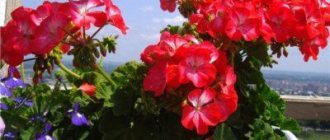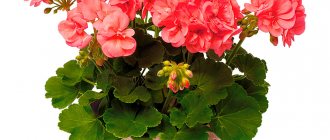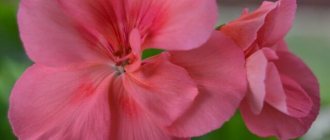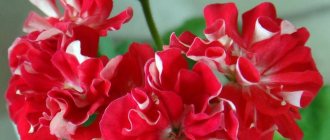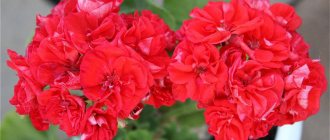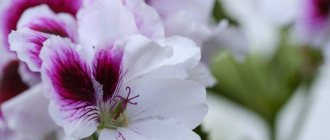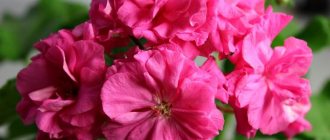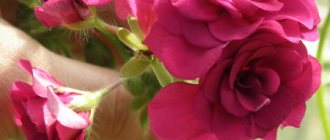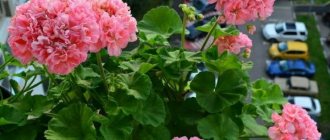Peculiarities
Pelargonium is a decorative flower from the Geraniaceae genus. To date, descriptions of about 250 species of this plant are known. Pelargonium is popularly called geranium, although this is scientifically incorrect. Plants belong to the same genus, but differ in appearance and have their own growing characteristics. Pelargonium, unlike geranium, is a heat-loving plant and does not overwinter in open ground. These two types of geraniums are united by the shape of the flower and the seed capsule, similar to the beak of a crane, for which the flowers got their name (geranium in Greek means “crane”).
A perennial herbaceous plant with an erect or creeping branched stem, it is grown in mid-latitudes as an indoor plant, which in the warm season is taken out to the balcony or placed in the garden. Carved leaves can be simple or dissected, with a velvety surface. Depending on the type of plant, the color of the leaves is solid green or with pronounced alternating light and dark zones. Types of geraniums with leaves of varying colors belong to the group of zonal pelargoniums.
Umbrella inflorescences of pelargonium, collected from simple or double flowers, are distinguished by their bright colors. Depending on the plant variety, the buds are single-colored or have several colors.
Due to the content of essential oils, geranium is used for medicinal and cosmetic purposes.
More information about the ampel Pelargonium ivy-leaved
This type of pelargonium also belongs to the Geraniaceae family, but it is distinguished by the flattened shape of the leaf blade. Its leaves have a five-lobed shape, like ivy. The surface of the sheet plate is smooth and glossy.
In nature, ivy-leaved pelargonium has very strong leaves that can break through rocky soil. When grown indoors, they become softer and smaller.
The shoots of the plant are long and curly. Since the stems hang down, it is best to grow pelargonium in pots or cache-pots. The inflorescences of this species are similar to umbrellas, because one bunch can contain from five to nine flowers. The flowering period of the plant is not too long. It starts in spring and ends in July. The color range of inflorescences is also rich. On sale you can see planting material with almost any shade of flowers. Flowers may be unevenly colored, for example, have spots, stripes, borders, inclusions that differ from the main color.
Pelargonium and geranium are often confused, but they are not the same plant, they simply belong to the same family. Pelargonium was brought to European countries at the beginning of the 17th century from Africa. The length of an adult plant can reach one and a half meters, so it is better to place the flower on a stand or grow it on a balcony. In nature, this species can be found in Italy, Spain or China. It prefers to grow in hot or temperate climates.
Among the plant species you can find varieties with double flowers, which are shaped like roses or tulips. Usually the inflorescences are collected in umbrellas, and the flowers themselves have bright, rich colors. They can combine two tones.
Many varieties of hanging plants are created through selection, for example, the result of crossing ivy-leaved and zonal pelargonium was the group of hybrid varieties Toskana. These include Malaika, Marlen, Teske, Nixe. No less known to gardeners is the Tornado hybrid group, which can bloom for up to six months.
Varieties
Pelargoniums of any group have several series, differing in height, color and leaf shape. The flowers of the Toscana series are zonal. These low plants are characterized by a compact bush, large umbrellas of inflorescences and a flowering duration of about a month. Pelargonium Toscana has several varieties, differing in the colors of the buds.
- Toscana is a low branched bush, decorated with very beautiful inflorescences up to 100 mm in diameter, which when half-bloomed resemble a rosebud. The simple leaves of the plant have one dark ring located close to the petiole of the leaf.
- Toscana Bernd is a semi-double variety with red flowers that have a slightly brownish tint. From the middle of the bud, sparse white stripes are scattered across the petals. When the flower begins to wilt, the edges of the petals lose color, resulting in the inflorescence taking on a frosted appearance.
- Toscana Edwards is a double variety with bright orange flowers. The underside of the petal is whitish in color. The plant has short, strong peduncles. Edwards blooms early and produces profusely.
- Variety "Eric", or "Castello Orange" , is famous for its perfectly orange semi-double flowers among dark green foliage with a light zone in the center.
- Toscana Hero is a dwarf plant with simple bright crimson flowers with a white eye in the center. Light green leaves have faint dark zones.
- The soft pink geranium "Karen" with simple flowers in lush inflorescences rising above the dark foliage captivates with its tenderness.
- Tammo is a compact dark green bush with a cap of large inflorescences of simple fuchsia flowers with a dark red velvety spot in the center of the petal.
- Dolce Vita Lavender Lara has large pink-lavender simple flowers with a lightened center. The green leaves of the plant do not have distinct zones.
- Angeleyes amarillo burgundy is a hybrid developed from the compact royal variety Angeline. Flowers of this species resemble the shape of a pansy. Small green leaves are covered with a cap of few-flowered inflorescences of simple flowers the size of a five-ruble coin. The two upper large petals with a jagged edge and the three smaller lower petals are burgundy in color with a soft lilac edge. At the center the petals are covered with a light mesh.
- Pelargonium Regina has large umbrellas of semi-double flowers of crimson color with an orange center, rising above green leaves with a pronounced dark zone.
- Lenja has large semi-double salmon-colored flowers with a lighter border, collected in large spherical umbrellas.
- "Katarina" is a compact plant with medium green foliage and a faint zone. A cap of large lilac flowers with a pink tint and a red center adorns the plant for about a month.
Basic rules of care
The basis for caring for plants is watering and fertilizing. Native to South Africa, pelargonium tolerates some drought but does not tolerate spraying or showering its flowers and leaves well. Water the flower in the pot with warm, soft water so that only the top layer of soil is moistened. Excess moisture is drained from the pan, preventing the water from stagnating.
During the hot season, daily watering is recommended, and when the plant goes into a dormant period, the frequency of watering is reduced to twice a week.
You can feed the flower with special fertilizers for flowering plants that contain a minimum of nitrogen, since this element causes rapid growth of green mass to the detriment of flowering. Organic fertilizers for geraniums are not recommended, but you can water them with an iodine solution by adding just one drop of the substance per liter of water . The liquid is spilled along the edge of the pot so as not to burn the roots.
Geranium loves well-lit places where it needs to be protected only from the bright midday sun. Due to lack of light, zonal pelargonium loses its brightness, the leaves become monochromatic, and the stems become elongated. The best length of daylight for long and lush flowering is 12–14 hours.
In winter, you can use additional lighting to preserve the decorative appearance of the flower.
In autumn, when flowering ends, and in early spring, geraniums are pruned to form a bush. The peculiarity of the flower is that during the process of growth its lower leaves constantly die off, which is why the plant stretches out and the bush becomes loose and ugly. You can trim to the required height, even if bare stems remain. They have dormant buds, which after pruning will begin to develop, producing new shoots.
Pelargonium Zonal Toscana Trend Neon Blue
All vegetative plants marked "PLANT FOR SPRING SALES"
are being prepared for distribution in the spring with 100% advance payment for the order. The price of an item in the vegetative plants section is the full cost of the item. Prepayment is a necessary measure that gives us a guarantee for the subsequent purchase of plants by the customer.
The supply of planting material is limited!
ATTENTION!
Suppliers of seedlings from Holland reserve the right to change the assortment up to 15% at the time of delivery; this can happen if any variety has not grown, disappeared or become ill. In such cases, selection and replacement is at the discretion of the customer, or compensation in monetary terms for the missing variety.
Payment
Minimum order of vegetative plants is 14 pcs. for an amount from 1500
rub.
All seedlings are expected from Holland in the first half of February, so the final price for the plant may be adjusted depending on the exchange rate at the time of receipt.
Payment must be made within 7 days after placing the order. After payment, you must send all payment details by email: amount, date of payment, last digits of the card, you can have a photo or scan of the receipt. If there is a need to additionally order any more plants, this can be done in subsequent orders with the obligatory note in the comments field to the order “Combine with No...”. Number of plants to order
To send your order, we use two types of mailing boxes depending on the number of plants ordered: L size boxes: 14–18 pcs. XL size boxes: 30–35 pcs. For delivery by bus, the number of plants is not limited. To send by mail, in addition to vegetative plants, the order can include goods from the “Flower Seeds” and “Professional Fertilizers” sections, except for those in 500 g packaging. For delivery by bus, any other product can be included in the order. Travel time
Travel time should not exceed 8–10 days, as longer periods can be detrimental to plants. 10 days are already risks! All questions regarding the time the order is in transit and the cost of delivery should be agreed upon independently in your Russian Post offices, or on the Post website: https://www.pochta.ru/parcels. Before placing an order, it is advisable to use the Russian Post calculator to calculate how much it will cost to deliver the parcel and how many days it will be in transit. The weight of one plant including packaging is 250 g. The weight of a box with an average order (16–18 plants) is 4500–5000 kg.
Quality of vegetative plants
The arrival of cuttings from Holland is expected on February 5–15, after which they are all planted in 250 ml containers.
The substrate in which the cuttings are planted consists of universal soil, professional peat substrate with the addition of agroperlite and sand. Before the start of mailings, plants are grown, formed, and at the time of mailings grow from the concept of “cuttings” for a minimum of one month and a maximum of two. All plants have a well-developed root system and a branched above-ground part. Plants are carefully prepared for shipment and securely packaged. A week before departure, they are treated with fungicides to prevent rotting during the journey. On the eve of dispatch, we treat it with professional anti-stress preparations for better preservation during shipment. Before shipping, if desired, the plants are photographed and the photo is sent to the customer. The packaging of plants before shipping is very careful, time-tested. Containers with plants are packed so that when the box is turned over, the soil does not spill, the earthen ball is not disturbed, and the leaves are not damaged. Next, the plants are packaged in a cardboard tube and secured very firmly with tape. Due to such a painstaking process of packaging our plants, which takes a lot of time, the supply for delivery by mail is limited. Start of mailings
Mailings will begin approximately on March 10 for southern regions, from March 25 in more northern regions.
Orders from customers from the southern region, upon agreement, can be sent by bus at an earlier date - during February at above-zero temperatures. The timing of orders will be individually agreed upon with each person, taking into account all the customer’s wishes, weather conditions and our capabilities. Delivery
BY TRANSPORT COMPANIES WE DO NOT SEND VEGETATIVE PLANTS!
Most transport companies were prohibited from accepting cargo if the package contains plants - rooted cuttings, seedlings, potted varieties of flowers, etc., since they cannot be responsible for their safety in transit. If the inventory of the shipped cargo indicates cuttings, seedlings and other living plants, such cargo will not be accepted!
Sending of vegetative plants is carried out by postal services, regular passenger buses and self-pickup. In Krasnodar, once a week, in agreement with the client, orders are delivered by our transport.
1. Russian Post
The price for delivery by Russian Post parcels will be calculated individually using the Russian Post calculator, depending on the estimated cost, weight and destination. Sending by 1st class parcel is possible - this is an expedited type of air delivery. Rates for this type of delivery are more expensive, with restrictions on the weight and size of the mail box. This box will fit no more than 6 plants. We have an estimated cost of a parcel with vegetative plants: 100 rubles. If you want to increase the estimated cost of the parcel, then you must also notify us about this when placing your order in the “Comment on the order” field. When choosing delivery by Russian Post, before sending the order, you will need to pay for delivery; all buyers will be informed about this by phone or in writing by e-mail. The average price of a parcel is 450–600 rubles. The price indicated is approximate, it depends on the shipping distance, weight and estimated cost of the shipment. The price includes a shipping box and individual packaging of plants. 2. Regular passenger buses
Dispatch in accordance with bus station schedules. Dispatch from Slavyansk-on-Kuban and Krasnodar. Delivery to the bus station in Krasnodar 200 rubles. At all bus stations in Krasnodar there is a mandatory inspection of luggage that will be placed in the cargo compartments of buses, the price of such inspection is 100 rubles. For these expenses the amount of 300 rubles. Payment will be required before the order is shipped. For delivery services by regular buses, the buyer pays independently upon receipt of the goods. Attention! Before placing an order with bus delivery, you must check at your bus stations about the availability of flights through your locality from Slavyansk-on-Kuban and Krasnodar, as well as their schedule.
3. Pickup
Before arriving, be sure to inform us by phone about your visit two days in advance so that the order is completed before the client arrives. All orders for pickup must be placed in advance on the IM website. Guarantees
We cannot be responsible for the safety of plants in transit. Before placing an order, analyze all the risks associated with delivery. This is especially true for remote regions.
Recommendations for plant adaptation after receipt
All plants are subject to careful inspection. Pay special attention to those plants that show signs of decay. All rotten branches are carefully trimmed, the sections are treated with charcoal or crushed activated carbon tablets. Apply Previkur under the root - 1 ml per 1 liter, treat the leaf with the fungicide Quadris - 1.2 ml per 1 liter of water (without getting into the ground). Alternative fungicide for suppressing pathogenic microbes and bacteria Topsin M, leaf treatment, consumption 1, 1.5 g. per 1 liter of water. In case of rotting of the root system and extensive damage to the aerial part by putrefactive processes, treat one leaf at a time and pour the biobactericide “Fitolavin” under the root: consumption 2 ml per 1 liter of water. When applying foliar treatments, using the proposed fungicides, add an anti-stress drug based on amino acids “Amnokat” to the tank mixture - consumption of 2.5 ml per 1 liter of water, or “Foliton” - 2 ml per 1 liter of water. Isabion is also effective - 4 ml per 1 liter of water. Repeat this procedure after 8–10 days. Healthy plants, but yellowed during travel from lack of light, should be placed in a bright place without direct sunlight for the first week. Treat in one mixture “Aminokat” (“Foliton”, “Megafol”, “Isabion” - one of the available ones) plus “Epin”. After 4 days, to completely restore the foliage, treat with iron chelate “Ferovit” according to the instructions. It is sold in retail chains. Or “Brexil Fe” - the norm is 1 g per 1 liter of water, an overdose is not advisable, since the plants are still weakened. Or “Kelik mix” - 1.5 ml per 1 liter of water. “Ferrofort Fe”, “Rexolin ABC” are very good - 1 g per 1 liter of water, treatment per sheet. If after 5–6 days the foliage does not recover, repeat the treatment with iron chelate again. Root feeding for relatively well-preserved seedlings should begin 3–4 days after receiving calcium nitrate 1.5 g per 1 liter of water, a week later with potassium monophosphate 1 g per 1 liter of water. Start feeding rotten plants after therapy no earlier than 7–9 days after receiving them; take the dosage of fertilizers at half the normal rate.
Before transplanting, you need to make sure that the cutting has withstood transportation and adaptation well, and that its leaves and root system continue to develop confidently. A pot for the plant should be selected with a volume no more than 2.5 times its previous volume. For pelargonium, the pot is no more than 0.6 liters. For ampelous petunia, begonia and other plants, no more than 1 liter is enough. Transfer to the final pot (plant pot) after the plant has grown well in the intermediate one.
Diseases and pests
Even such an unpretentious plant is affected by pests and fungal diseases. In order to protect the plant from disease, you need to follow the watering regime, preventing powdery mildew, rust or gray rot from developing.
If signs of disease appear, the plant must be treated with fungicides. If a flower is affected by blackleg, the flower will have to be completely destroyed and the container disinfected.
Pelargonium has medicinal properties and repels most pests, but some sucking insects (like whiteflies or spider mites) can attack the plant. Insecticides are used to combat them.
Reproduction
You can get new plants:
When propagated by seeds, especially those obtained at home, it is possible to obtain completely different plants that differ from the mother plant. Therefore, it is better to use seed grains purchased in specialized stores. Sowing of seedlings is carried out in the second - third month of winter:
- seeds are distributed over the surface of moist soil, sprinkled with a thin layer of earth;
- cover with film and place in a warm, bright place;
- shoots will appear in a week;
- when the seedling has two true leaves, they are picked one at a time - two seedlings per pot;
- When 5–6 leaves appear, the first pinching is performed.
For propagation, you can take twigs obtained by trimming a flower, or specially cut cuttings 2.5 cm long. Dry the cut area and sprinkle it with root growth stimulants. Plant the prepared cuttings in moist soil and leave uncovered. With regular watering and an air temperature of about 21°C, rooting occurs within 2–3 weeks. When the sprout produces five leaves, you need to pinch the crown.
If you follow these simple rules of care, pelargonium will reward you with lush, long-lasting flowering.
You can learn more about growing Pelargonium in the following video.
Most popular varieties
Several species of ivy-leaved pelargonium have now been selected. Among them, gardeners give preference to several varieties because of their decorative properties.
Angel
This plant is not too tall. It can grow up to 30 centimeters in height. Outwardly, it looks like a pansy. Flower growers often grow it at home. This variety is quite hardy compared to others. and it is not difficult to care for. To make the composition look more decorative, you can plant several flowers at once in one container. So, the bushes look more lush.
Tuscany Eva
This variety of flower is most loved by gardeners because of its short growth and beautiful snow-white flowers. The height of the bush reaches half a meter. It begins to bloom in May and pleases its owner with flowering until the frost.
Tornado
This variety is the result of the work of Dutch breeders. Bushes of the "Tornado" variety are low, about 30 centimeters. Bright red buds bloom on it. In gardens and apartments it can be seen growing in flowerpots and hanging baskets.
PAC Pink Sybil
This variety is valued for its double pink inflorescences. Externally, such pelargonium can be mistaken for a decorative rose. PAC Pink Sybil blooms early, but its flowering period itself is long.
PAC Sally
This species is characterized by lush flowering. The plant has a large number of dark burgundy flowers with a terry surface on the bushes. Inflorescences can merge into entire caps of flowers.
Toscana Josina
Characteristic features of the variety: double flowers with a rich lilac hue and an abundance of small two-color leaves.
Toscana Okka
The plants will delight their owner with bright orange flowers collected in inflorescences. On the petals of Toscana Okka flowers. as if painted, white stripes.
Toscana Malaika
This is an early blooming pelargonium variety with purple-pink inflorescences. The Toscana Malaika bush blooms profusely. No less popular for breeding and growing are the varieties “Amethyst” or “Rhapsody”.
Appearance and characteristics of pelargoniums
There are about 250 varieties of Pelargonium Toscana. The most favorite plants of gardeners are Bernd pelargonium, Regina species, Tammo and others.
The stem of the flower can be straight or curly, and the leaves can be carved and terry. But the defining characteristic feature is the inflorescences themselves - bright or soft pink flowers of 4 petals, which are collected together into a bouquet.
Royal pelargonium is valued for the unusual color of its semi-double petals.
This is interesting! Sometimes in descriptions the flower is called “Tuscan geranium”, but this is wrong, pelargonium just belongs to the geranium genus.
Description of popular varieties of pelargonium from the Toscana series
Pelargonium Tuscany is especially popular. This is due to the fact that it can bloom all year round and is unpretentious in home and garden conditions. The lush bush not only decorates with delicate terry umbrella inflorescences, but also exudes a pleasant spicy aroma. The most popular varieties:
- Pelargonium Toscana Bernd. It is distinguished by large semi-double flowers up to 3.5 cm each and a rich cherry color. It is similar to the Tammo variety. Pelargonium Tuscany Bernd can be planted indoors, on the balcony or in the garden.
- Pelargonium Edwards Tuscany. It also has tight inflorescences and a lush shape. Pelargonium flowers of the Edwards Toscana variety resemble rosebuds.
- Variety Tuscany Renske. It has compact bushes with double burgundy flowers. The flowering period is from early spring to late autumn.
- Toscana Castello. Named after the beautiful castle, it amazes with its grandeur. Widely branched, colors range from white and soft pink to purple.
- Toscana Hero. Gardeners call this variety standard. The small size of the Hiro stem is combined with rich flowering.
Delicate bouquet of Edwards pelargonium inflorescences
Pelargonium Tuscany and its varieties Edwards, Bernd and others
Bright pelargoniums have long been decorating the windows of homes, schools and hospitals. The beauty is unpretentious in care and adapts to almost all living conditions. And its beautiful voluminous umbrellas of inflorescences are colorful against the background of fluffy round leaves.
Appearance and characteristics of pelargoniums
The plant is a small bush that can be easily shaped. Pruning only helps to increase the green mass of the plant. If you care for pelargonium correctly, it blooms all year round.
Variegated geranium Tuscany
Description of popular varieties of pelargonium from the Toscana series
Thanks to the work of breeders, the color palette is wide, from soft marshmallow (Regina variety) to rich scarlet with dark spots (Dark Red variety). Varieties differ in color, shape, size and type of inflorescences.
Toscana Bernd
Pelargonium Toscana Bernd is a double and zonal beauty. Rare deep red color of inflorescences collected in bright bunches. Pelargonium Tuscany Bernd blooms profusely, covering the entire top with red balls.
Toscana Edwards
Pelargonium with red-orange inflorescences is distinguished by a white lining on the back of the petals and at their base. Pelargonium Edwards Tuscany blooms earlier than its sisters and blooms for a long time.
Toscana Renske
The red-burgundy small inflorescences of this variety densely cover the surface of the compact bush. The plant can be used as a hanging or potted plant. Blooms early and blooms for a long time.
Toscana Castello
Varieties of this variety come in many shades of red and pink. The inflorescences are dense and resistant to fading. The bush is medium, erect, suitable for planting in flower beds.
Toscana Hero
A beautiful combination of dark red-pink spots on the petals, with a white tint. The hiro bush is dwarf, and the inflorescences themselves are very large. The velvet shade shimmers in the sun. Blooms profusely, almost continuously. For many, street sex is still an unrealistic sexual dream, but for chicks from https://pornobolt.tv/na-ulice this is their favorite pastime. Those who are more modest fuck in nature or on some abandoned place, and those who are bolder can have sexual intercourse in a public place without any shame. Lust drives the sluts so crazy that they become ready to fuck even when a whole crowd of passersby starts watching them, filming them on their smartphones! . Medium size with the same flower color - Tammo geranium.
Planting and further care of ivy-leaved pelargonium Tuscany
The non-capricious Tuscany geranium grows wonderfully both in pots and in flower beds in the summer.
When planting bushes in open ground, it is important to consider that the roots of the plant are quite long. The depth of the hole should be at least 20 cm. The average distance between standard bushes is 30-35 cm.
Watering, spraying and fertilizing
Watering is needed moderate but regular. The plant will not tolerate stagnation of moisture, nor will it tolerate drying out of the soil.
Important! Spraying will not be beneficial, since moisture will only be retained on the pile of terry leaves.
To maintain flowering, it is important to fertilize the bush once every 14 days, feeding pelargonium with a universal complementary food for flowering plants. In winter, the plant takes a break from fertilizers.
Trimming
Pruning is carried out for the purpose of:
- forming a compact bush;
- for thickening the bush;
- to stimulate flowering by removing shoots that are too long.
Pelargonium pruning should be done on an ongoing basis, starting from early pinching of the cuttings.
Reproduction
The flower is easily propagated by seeds and cuttings. Planting material requires maintaining greenhouse conditions - moisture, heat and light for at least 12 hours so that the cuttings do not stretch.
Diseases and pests. Means to combat them
The smell of leaves and flowers repels many pests and insects. Whiteflies or spider mites can live on greenery if preventative treatments are not carried out on time.
Pests on geraniums
Improper watering regime contributes to the formation of gray rot, powdery mildew, and rust.
Pelargonium is a wonderful decoration for any home interior or garden bed. Its unpretentiousness and continuous flowering in the summer season make it a favorite of gardeners.
Planting and further care of ivy-leaved pelargonium Tuscany
Caring for ivy-leaved pelargonium Tuscany is simple. Planting technology may vary depending on the location of cultivation, since the crop grows well in the room, on the balcony and in the garden.
Planting a plant
The flower prefers relatively hard soil, which combines turf and leaf soil, peat and sand. It is important to take care of the looseness and filling of the soil with oxygen.
Watering, spraying and fertilizing
Before and after planting, the plant is watered abundantly for two weeks. Then, in hot weather, it can be watered every other day, and in cold weather - 2 times a week. It is better to install drainage under the pot to absorb excess moisture. Spraying the flower is necessary only on very hot days.
Note! To bloom for many months, you should fertilize the flower with universal compounds at least once every two weeks.
Trimming
The procedure is required to achieve maximum flowering duration. There are three types of pruning:
- The main thing is that it is done in early spring; you can safely trim the long stems and give them shape, since new ones grow very quickly.
- Autumn - removal of dry leaves and diseased stems.
- Pinching throughout the year.
How to prune a flower
Reproduction
Reproduction is carried out in three ways: seeds, cuttings and dividing the bush.
